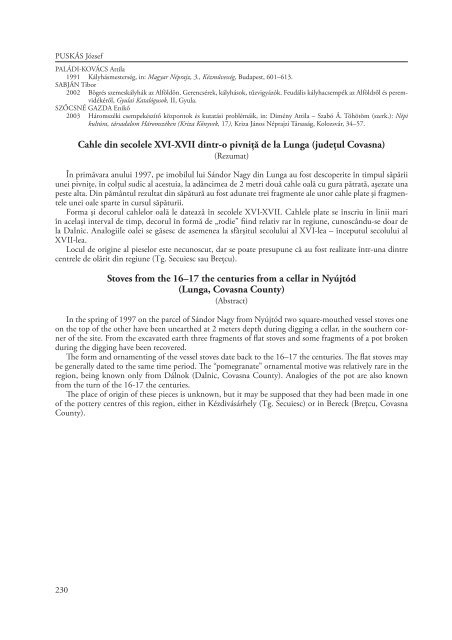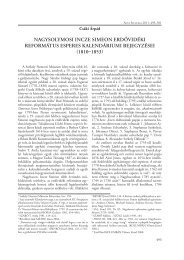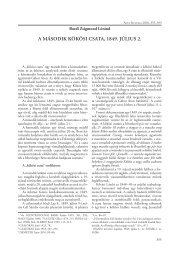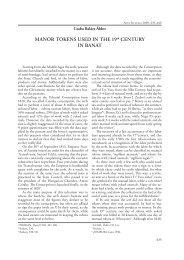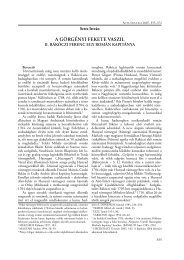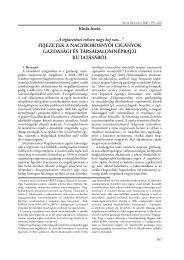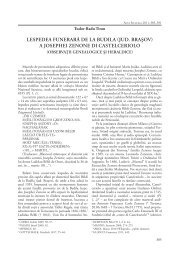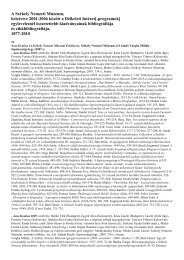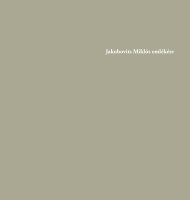16â17. százAdi kályhAszemek és kályhAcsempe-töredékek egy ...
16â17. százAdi kályhAszemek és kályhAcsempe-töredékek egy ...
16â17. százAdi kályhAszemek és kályhAcsempe-töredékek egy ...
You also want an ePaper? Increase the reach of your titles
YUMPU automatically turns print PDFs into web optimized ePapers that Google loves.
Puskás József<br />
PALÁDI-KOVÁCS Attila<br />
1991 Kályhásmesterség, in: Magyar Néprajz, 3., Kézművesség, Budapest, 601–613.<br />
SABJÁN Tibor<br />
2002 Bögrés szemeskályhák az Alföldön. Gerencsérek, kályhások, tűzvigyázók. Feudális kályhacsempék az Alföldről és peremvidékéről,<br />
Gyulai Katalógusok, II, Gyula.<br />
SZŐCSNÉ GAZDA Enikő<br />
2003 Háromszéki csempekészítő központok és kutatási problémáik, in: Dimény Attila – Szabó Á. Töhötöm (szerk.): Népi<br />
kultúra, társadalom Háromszéken (Kriza Könyvek, 17), Kriza János Néprajzi Társaság, Kolozsvár, 34–57.<br />
Cahle din secolele XVI-XVII dintr-o pivniţă de la Lunga (judeţul Covasna)<br />
(Rezumat)<br />
În primăvara anului 1997, pe imobilul lui Sándor Nagy din Lunga au fost descoperite în timpul săpării<br />
unei pivniţe, în colţul sudic al acestuia, la adâncimea de 2 metri două cahle oală cu gura pătrată, aşezate una<br />
peste alta. Din pământul rezultat din săpătură au fost adunate trei fragmente ale unor cahle plate şi fragmentele<br />
unei oale sparte în cursul săpăturii.<br />
Forma şi decorul cahlelor oală le datează în secolele XVI-XVII. Cahlele plate se înscriu în linii mari<br />
în acelaşi interval de timp, decorul în formă de „rodie” fiind relativ rar în regiune, cunoscându-se doar de<br />
la Dalnic. Analogiile oalei se găsesc de asemenea la sfârşitul secolului al XVI-lea – începutul secolului al<br />
XVII-lea.<br />
Locul de origine al pieselor este necunoscut, dar se poate presupune că au fost realizate într-una dintre<br />
centrele de olărit din regiune (Tg. Secuiesc sau Breţcu).<br />
Stoves from the 16–17 the centuries from a cellar in Nyújtód<br />
(Lunga, Covasna County)<br />
(Abstract)<br />
In the spring of 1997 on the parcel of Sándor Nagy from Nyújtód two square-mouthed vessel stoves one<br />
on the top of the other have been unearthed at 2 meters depth during digging a cellar, in the southern corner<br />
of the site. From the excavated earth three fragments of flat stoves and some fragments of a pot broken<br />
during the digging have been recovered.<br />
The form and ornamenting of the vessel stoves date back to the 16–17 the centuries. The flat stoves may<br />
be generally dated to the same time period. The “pomegranate” ornamental motive was relatively rare in the<br />
region, being known only from Dálnok (Dalnic, Covasna County). Analogies of the pot are also known<br />
from the turn of the 16-17 the centuries.<br />
The place of origin of these pieces is unknown, but it may be supposed that they had been made in one<br />
of the pottery centres of this region, either in Kézdivásárhely (Tg. Secuiesc) or in Bereck (Breţcu, Covasna<br />
County).<br />
230


